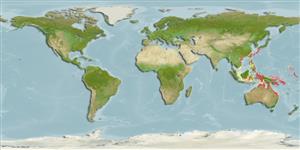>
Callionymiformes (Dragonets) >
Callionymidae (Dragonets)
Etymology: Callionymus: Greek, kallion, comparative of kallos = beautiful + Greek, onyma = name; with a better name .
Environment: milieu / climate zone / depth range / distribution range
Ecologia
marinhas demersal; intervalo de profundidade 3 - 29 m (Ref. 75992). Tropical
Western Pacific: Papua New Guinea.
Tamanho / Peso / Idade
Maturity: Lm ? range ? - ? cm
Max length : 89.1 cm SL macho/indeterminado; (Ref. 39216)
Espinhos dorsais (total) : 4; Raios dorsais moles (total) : 9; Raios anais moles: 8. Head and body light brown, back with small whitish spots, sides with dark blotches and small dark spots. First dorsal fin dusky in males, distal margin blackish, with an elongate black blotch basally on second membrane. First dorsal fin blackish in females, first membrane whitish. Second dorsal fin in males with narrow horizontal streaks, anal fin in males with a distal black streak. Caudal, pectoral, and pelvic fins spotted with brown (Ref 42832).
Life cycle and mating behavior
Maturities | Reprodução | Spawnings | Egg(s) | Fecundities | Larvas
Kailola, P.J., 1987. The fishes of Papua New Guinea: a revised and annotated checklist. Vol. II Scorpaenidae to Callionymidae. Research Bulletin No. 41, Research Section, Dept. of Fisheries and Marine Resources, Papua New Guinea. (Ref. 6192)
Categoria na Lista Vermelha da IUCN (Ref. 130435)
Ameaça para o homem
Harmless
Utilização humana
Ferramentas
Relatórios especiais
Descarregue XML
Fontes da internet
Estimates based on models
Preferred temperature (Ref.
123201): 25.1 - 29.3, mean 28.4 °C (based on 1118 cells).
Phylogenetic diversity index (Ref.
82804): PD
50 = 0.5000 [Uniqueness, from 0.5 = low to 2.0 = high].
Bayesian length-weight: a=0.00912 (0.00408 - 0.02036), b=2.77 (2.59 - 2.95), in cm total length, based on LWR estimates for this Genus-body shape (Ref.
93245).
Nível Trófico (Ref.
69278): 3.5 ±0.4 se; based on size and trophs of closest relatives
Resiliência (Ref.
120179): Muito baixo, tempo mínimo de duplicação da população maior que 14 anos (Preliminary K or Fecundity.).
Fishing Vulnerability (Ref.
59153): High to very high vulnerability (65 of 100).
